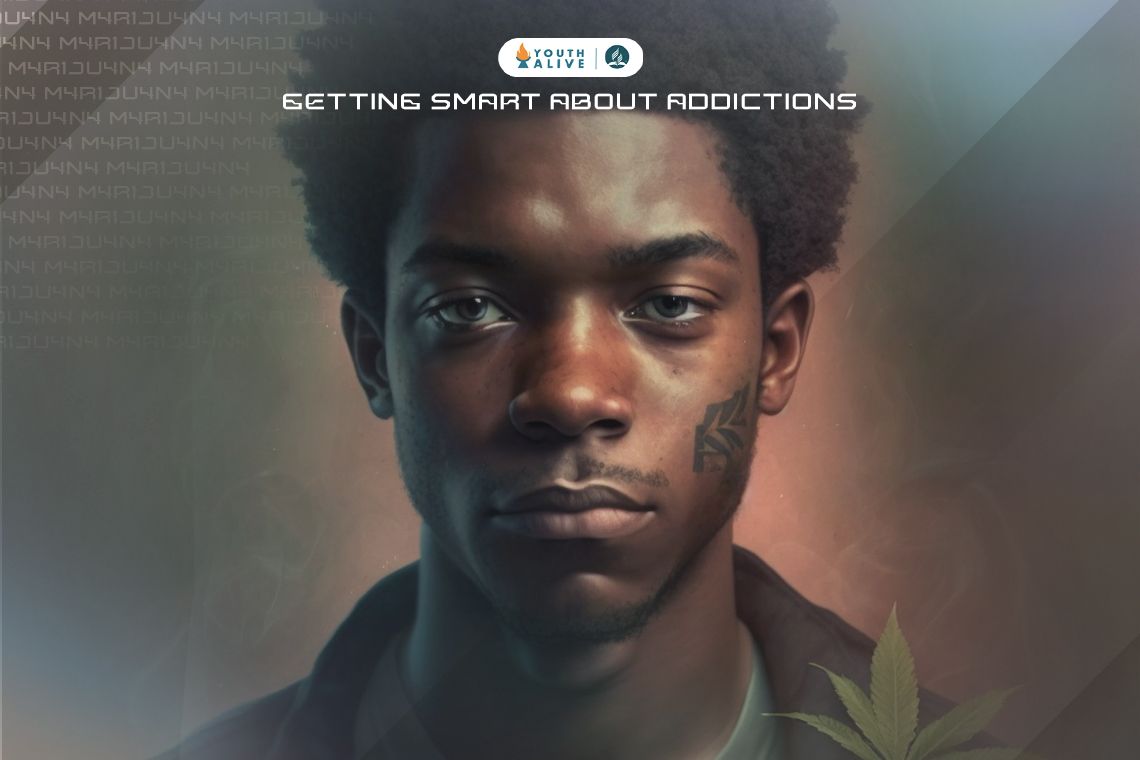TRENDS IN MARIJUANA USE – Marijuana is the second-most-used brain-altering substance in the world after alcohol. The use of marijuana has increased among high school seniors reporting they have used it at least once, and about 20 percent of students at a faith-based university reporting that they have tried marijuana at least once in the previous year.
ORIGIN AND ORIGINAL USES – The marijuana plant (also called hemp) is an ancient plant that originally came from China and eventually found its way to Europe and then around the world. The hemp plant has several practical uses. The plant’s stem was—and still is—used to make rope and clothing; its seeds are edible. The plant was also burned as a part of religious rituals.[i] Hemp is still widely used in industry even today.
THE CHEMICAL IN MARIJUANA THAT AFFECTS YOUR BRAIN – The chemical in the marijuana plant that affects your brain is delta-9-tetrahydrocannabinol (THC) and is concentrated in the leaves of the female plants. Wild marijuana has less that 1% THC, but today most marijuana available is 10-15%, and THC oils contain about 90% THC or higher.[ii]
YOUR BRAIN ON MARIJUANA – Marijuana is primarily used in two forms; smoked/vaped or eaten in baked goods (cookies, candy, brownies). Some users report feelings of pleasant calmness and euphoria. Others experience respiratory problems, hallucinations, and psychotic episodes.
MARIJUANA AND EMERGENCY ROOM (ER) VISITS – Recent research found that marijuana users are 22% more likely to need a hospital ER visit for acute intoxication, respiratory problems, and physical injury. The higher the THC level someone takes in, the greater the risk of a serious reaction.[iii] A nationwide review found that the number of children who needed medical intervention after ingesting cannabis (marijuana) rose from 207 in 2017 to 3,054 in 2021. The children had found what looked like regular candy or cookies that contained THC. The majority (52%) of the victims were under 4 years old, could not read the packaging labels, and ate what looked like regular candy or cookies.[iv]
MARIJUANA AND MENTAL HEALTH – Research has shown that if the marijuana used is more than 10% THC, users are five times more likely to experience a psychotic episode (hallucinations, schizophrenia) than nonusers.[v] Research has also shown that marijuana can be addictive.[vi]
MARIJUANA AND SUICIDE – Suicide among youth is a major concern worldwide, and the use of marijuana contributes to this risk. In a review of a wide variety of studies, it was found that young adult marijuana users were more likely to experience depression and were three times more likely to attempt to commit suicide than nonusers.[vii]
MARIJUANA AND THRIVING – A recent study followed individuals from adolescence to age 50 and found that lifetime users of marijuana were more likely to not finish college, have poorer mental and physical health, be on welfare, and have less satisfactory lives than comparable non-users.[viii]
MARIJUANA AND ITS REALITY – Mental health professionals counseling young marijuana users have consistently found that frequent marijuana users do poorly in school. The marijuana users often come to realize that their earlier hopes and plans for their future are not going to happen because of cognitive impairment. But frequently, these young people have a hard time stopping their marijuana habits, even if they get into trouble with the law. Though these young people may have started using marijuana to treat their emotional problems, not only do their problems not go away, but they also get worse.
PROPSERING AND BEING IN GOOD HEALTH -- In 3 John 1:2, the Apostle wishes each of us to prosper and be in good health. The consumption of marijuana will likely not allow us to receive the blessing John prays for each of us to receive!
Questions & Answers
Q. ISN’T MARIJUANA LESS DANGEROUS THAN SMOKING CIGARETTES OR DRINKING ALCOHOL?
A. NOT NECESSARILY. The dangers are different. Smoking marijuana is a major cause of respiratory problems that result in emergency room (ER) visits for those at risk. Future studies will have to determine if it causes lung cancer. While marijuana does not appear to be related to violence like alcohol does, it does affect driving. It is a significant cause of physical injury (from impaired driving etc.) that results in ER visits. Edible marijuana-spiked candy bars are of particular danger to children. Many adult users don’t realize that a single candy bar with edible marijuana has multiple servings, so if a child eats the whole bar, it can make them sick to their stomachs and cause frightening hallucinations. The link between frequent high-potency marijuana use and psychosis is well established.
Q. CAN PEOPLE BECOME ADDICTED TO MARIJUANA?
A. YES, scientists have found that there are receptor sites for THC in the brain, and the frequent users of high potency marijuana can become addicted.
Q. IN THE PAST, PARENTS, TEACHERS, GOVERNMENT, AND RELIGIOUS LEADERS HAVE NOT FULLY RIGHT ABOUT THE DANGERS OF MARIJUANA, HOW CAN WE TRUST THEM NOW?
A. That is a good question, and it is correct. False information was provided about the dangers of marijuana that did damage to the credibility of experts. That information was not based on scientific observation but fear of something new. The information mentioned in this document is from published research data backed up by clinical experience. The data on emergency room visits, psychotic episodes, suicide attempts, and poorer life outcomes from use of high-THC marijuana are public data that anyone can examine. The references to each of the points made are provided so anyone can examine the data. Young people have their whole lives in front of them. But decisions made by young people can set a life direction that severely limits their future. The use of marijuana is not associated with good life outcomes. Christ came to give us life and life more abundantly. Marijuana use does not give us an abundant life but is associated with worse life outcomes!
Q. DOES MARIJUANA CAUSE THE PROBLEMS THAT HAVE BEEN CLAIMED? OR DO INDIVIDUALS WITH MENTAL HEALTH OR PHYSICAL PROBLEMS JUST USE MARIJUANA TO SELF-MEDICATE?
A. Researchers cannot randomly assign youth to use high-potency marijuana or urge them not to use it. Studies have done their best to compare equivalent groups. The driving impairment, physical injury, poorer life outcomes, and mental health problems occur after use. There is no evidence that marijuana is a mental health medicine. If youth are experiencing mental health issues, there is help and some medications that have been approved based on research. Marijuana has not been shown to have any positive outcome on mental health problems.
BEFORE YOU RISK IT
- Know the law – Marijuana is illegal at any age under U.S. federal law and is still illegal in many states in the U.S. Use in all US states is illegal for those under 21. Marijuana is also illegal in most countries around the world.
- Get the facts – While marijuana is less harmful than some drugs, it is not harmless. Use of marijuana is linked to using other drugs, declining intelligence and other cognitive/mental health problems, and overall poorer life outcomes.
- Know the Risks – Marijuana use causes driving impairment, accidents, and physical injuries. The use of marijuana with alcohol increases these risks.
- Regular current use is not the norm – While the majority of youth have tried marijuana, only about 20% of national high school seniors have used it in the last month. So, if you are not using marijuana, you are in the large majority of young people who have made a wide choice. Never let your peers influence you to do something that could harm you or your future. Choose wisely, and work to influence your friends to do so as well.
[i]Anthony, D.W. (2007). The Horse, the Wheel, and Language: How Bronze-Age Riders from the Eurasian Steppes Shaped the Modern World. Princeton University Press.
Ren, M., Tang, Z., Wu, X., Spengler, R., Jiang, H., Yang, Y., Boivin, N. (2019) The origins of cannabis smoking: Chemical residue evidence from the first millennium BCE in the Pamirs. Sci. Adv. 5, eaaw1391.
[ii] National Institute on Drug Abuse, (November 22, 2022). Cannabis (Marijuana Potency), https://nida.nih.gov/research-topics/marijuana/cannabis-marijuana-potency.Bell C, Slim J, Flaten HK, Lindberg G, Arek W, Monte AA. Butane Hash Oil Burns Associated with Marijuana Liberalization in Colorado. J Med Toxicol. 2015 Dec;11(4):422-5. doi: 10.1007/s13181-015-0501-0. PMID: 26289652; PMCID: PMC4675612.
[iii] Takakuwa K.M., Schears R.M. (2021). The emergency department care of the cannabis and synthetic cannabinoid patient: a narrative review. Int J Emerg Med. Feb 10;14(1):10. doi: 10.1186/s12245-021-00330-3. PMID: 33568074; PMCID: PMC7874647.Vozoris NT, Zhu J, Ryan CM, et al. Cannabis use and risks of respiratory and all-cause morbidity and mortality: a population based, data-linkage, cohort study. BMJ Open Resp Res 2022;9:e001216. doi:10.1136/ bmjresp-2022-001216
[iv] Tweet M.S., Nemanich A., Wahl M. (2023). Pediatric Edible Cannabis Exposures and Acute Toxicity: 2017–2021. Pediatrics; 151(2):e2022057761
[v] Di Forti M., Quattrone D., Freeman T.P., et al. (2019). The contribution of cannabis use to variation in the incidence of psychotic disorder across Europe (EU-GEI): a multicenter case-control study. Lancet Psychiatry; 6(5):427-436. doi:10.1016/S2215- 0366(19) 30048-3
[vi] Hasin D.S., Saha T.D., Kerridge B.T., et al. (2015). Prevalence of marijuana use disorders in the United States between 2001-2002 and 2012-2013. JAMA Psychiatry;72(12):1235-1242.
[vii] Gobbi G, Atkin T, Zytynski T, Wang S, Askari S, Boruff J, Ware M, Marmorstein N, Cipriani A, Dendukuri N, Mayo N. (2019) Association of Cannabis Use in Adolescence and Risk of Depression, Anxiety, and Suicidality in Young Adulthood: A Systematic Review and Meta-analysis. JAMA Psychiatry. Apr 1;76(4):426-434. doi: 10.1001/jamapsychiatry.2018.4500. Erratum in: JAMA Psychiatry. 2019 Apr 1;76(4):447. PMID: 30758486; PMCID: PMC6450286.
[viii] Terry-McElrath, Y.M., O’Malley, P.M., Johnston, L.D., Bray, B.C., Patrick, M.E., Schulenberg, J.E. (2017). Longitudinal patterns of marijuana use across ages 18–50 in a US national sample: A descriptive examination of predictors and health correlates of repeated measures latent class membership, Drug and Alcohol Dependence, Volume 171, Pages 70-83, ISSN 0376-8716,https://doi.org/10.1016/j.drugalcdep.2016.11.021.























